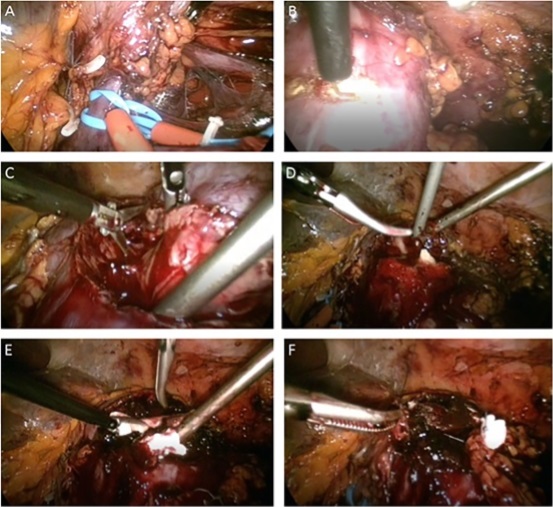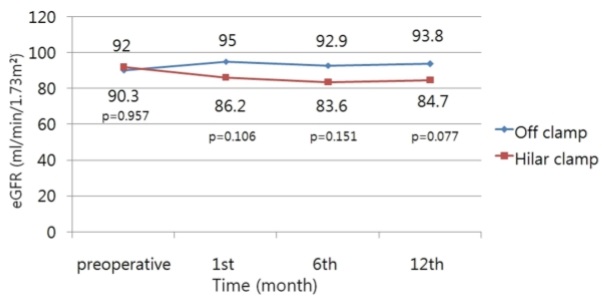Kosin Med J.
2018 Dec;33(2):191-199. 10.7180/kmj.2018.33.2.191.
Comparative study of off-clamp, laparoscopic partial nephrectomy (OCLPN) and conventional hilar control, laparoscopic partial nephrectomy (HCLPN) for renal tumors: One-year follow-up results of renal function change
- Affiliations
-
- 1Department of Urology, Kosin University Gospel Hospital, Kosin University College of Medicine, Busan, Korea. threeb74@naver.com
- KMID: 2430734
- DOI: http://doi.org/10.7180/kmj.2018.33.2.191
Abstract
OBJECTIVES
We designed the study to compare the oncologic and renal function outcomes of off-clamp, laparoscopic partial nephrectomy (OCLPN) and conventional laparoscopic partial nephrectomy (HCLPN) for renal tumors.
METHODS
Between March 2008 and July 2015, 114 patients who underwent laparoscopic partial nephrectomy (LPN) of a renal neoplasm were studied. We performed LPN without hilar clamp on 40 patients (OCLPN, Group 1), and conventional LPN with hilar control and renorrhaphy on another 40 patients (HCLPN, Group 2). We retrospectively reviewed the medical records of each patient's age, sex, R.E.N.A.L. nephrometry score (RNS), operation time, complications, hospitalization period, tumor size, positive resection margin, histologic classification of tumor, pathologic stage, Fuhrman grade, estimated blood loss (EBL), warm ischemic time (WIT), and estimated glomerular filtration rate (eGFR) before and one year after surgery.
RESULTS
There were no significant differences in age, sex, preoperative eGFR, EBL, surgical (anesthesia) time, and tumor size between the two groups. The mean eGFR was not significantly different between the OCLPN and HCLPN groups 1 month (95 and 86.2 mL/min/1.73 m², respectively; P = 0.106), 6 months (92.9 and 83.6 mL/min/1.73 m², respectively; P = 0.151) and 12 months (93.8 and 84.7 mL/min/1.73 m², respectively; P = 0.077) postoperatively. The change in eGFR after one year was 3.9% in the OCLPN group and −7.9% in the HCLPN group.
CONCLUSIONS
OCLPN was superior to HCLPN in preserving renal function one year after surgery, and there was no statistically significant difference in tumor treatment results.
MeSH Terms
Figure
Reference
-
1. Herr HW. Partial nephrectomy for unilateral renal carcinoma and a normal contralateral kidney : 10-year followup. J Urol. 1999; 161:33–34.2. Lee CT, Katz J, Shi W, Thaler HT, Reuter VE, Russo P. Surgical management of renal tumors 4 cm. or less in a contemporary cohort. J Urol. 2000; 163:730–736.
Article3. Simmons MN, Weight CJ, Gill IS. Laparoscopic radical versus partial nephrectomy for tumors >4 cm: intermediate-term oncologic and functional outcomes. Urology. 2009; 73:1077–1082.
Article4. Becker F, Siemer S, Hack M, Humke U, Ziegler M, Stöckle M. Excellent long-term cancer control with elective nephron-sparing surgery for selected renal cell carcinomas measuring more than 4 cm. Eur Urol. 2006; 49:1058–1063.5. Leibovich BC, Blute ML, Cheville JC, Lohse CM, Weaver AL, Zincke H. Nephron sparing surgery for appropriately selected renal cell carcinoma between 4 and 7 cm results in outcome similar to radical nephrectomy. J Urol. 2004; 171:1066–1070.
Article6. Porpiglia F, Volpe A, Billia M, Scarpa RM. Laparoscopic versus open partial nephrectomy : analysis of the current literature. Eur Urol. 2008; 53:732–742.7. Allaf ME, Bhayani SB, Rogers C, Varkarakis I, Link RE, Inagaki T, et al. Laparoscopic partial nephrectomy: evaluation of long-term oncological outcome. J Urol. 2004; 172:871–873.
Article8. Seifman BD, Hollenbeck BK, Wolf JS Jr. Laparoscopic nephron-sparing surgery for a renal mass: 1-year minimum follow-up. J Endourol. 2004; 18:783–786.
Article9. Gill IS, Abreu SC, Desai MM, Steinberg AP, Ramani AP, Ng C, et al. Laparoscopic ice slush renal hypothermia for partial nephrectomy: the initial experience. J Urol. 2003; 170:52–56.
Article10. Landman J, Venkatesh R, Lee D, Vanlangendonck R, Morissey K, Andriole GL, et al. Renal hypothermia achieved by retrograde endoscopic cold saline perfusion: technique and initial clinical application. Urology. 2003; 61:1023–1025.
Article11. Janetschek G, Abdelmaksoud A, Bagheri F, Al-Zahrani H, Leeb K, Gschwendtner M. Laparoscopic partial nephrectomy in cold ischemia: renal artery perfusion. J Urol. 2004; 171:68–71.
Article12. Thompson RH, Lane BR, Lohse CM, Leibovich BC, Fergany A, Frank I, et al. Renal function after partial nephrectomy: effect of warm ischemia relative to quantity and quality of preserved kidney. Urology. 2012; 79:356–360.
Article13. Funahashi Y, Hattori R, Yamamoto T, Sassa N, Fujita T, Gotoh M. Effect of warm ischemia on renal function during partial nephrectomy: assessment with new 99mTc -mercaptoacetyltriglycine scintigraphy parameter. Urology. 2012; 79:160–164.
Article14. Porpiglia F, Fiori C, Bertolo R, Angusti T, Piccoli GB, Podio V, et al. The effects of warm ischaemia time on renal function after laparoscopic partial nephrectomy in patients with normal contralateral kidney. World J Urol. 2012; 30:257–263.
Article15. Simon J, Meilinger M, Lang H, Hautmann RE, de Petriconi R. Novel technique for in situ cold perfusion in laparoscopic partial nephrectomy. Surg Endosc. 2008; 22:2184–2189.
Article16. Simon J, Bartsch G Jr, Finter F, Hautmann R, de Petriconi R. Laparoscopic partial nephrectomy with selective control of the renal parenchyma: initial experience with a novel laparoscopic clamp. BJU Int. 2009; 103:805–808.
Article17. Shao P, Qin C, Yin C, Meng X, Ju X, Li J, et al. Laparoscopic partial nephrectomy with segmental renal artery clamping: technique and clinical outcomes. Eur Urol. 2011; 59:849–855.
Article18. Shikanov S, Lifshitz D, Chan AA, Okhunov Z, Ordonez MA, Wheat JC, et al. Impact of ischemia on renal function after laparoscopic partial nephrectomy: a multicenter study. J Urol. 2010; 183:1714–1718.
Article19. Thompson RH, Lane BR, Lohse CM, Leibovich BC, Fergany A, Frank I, et al. Renal function after partial nephrectomy: effect of warm ischemia relative to quantity and quality of preserved kidney. Urology. 2012; 79:356–360.
Article20. Thompson RH, Lane BR, Lohse CM, Leibovich BC, Fergany A, Frank I, et al. Every minute counts when the renal hilum is clamped during partial nephrectomy. Eur Urol. 2010; 58:340–345.
Article21. Thompson RH, Lane BR, Lohse CM, Leibovich BC, Fergany A, Frank I, et al. Comparison of warm ischemia versus no ischemia during partial nephrectomy on a solitary kidney. Eur Urol. 2010; 58:331–336.
Article22. Gill IS, Eisenberg MS, Aron M, Berger A, Ukimura O, Patil MB, et al. "Zero ischemia" partial nephrectomy: novel laparoscopic and robotic technique. Eur Urol. 2011; 59:128–134.
Article23. D'Urso L, Simone G, Rosso R, Collura D, Castelli E, Giacobbe A, et al. Benefits and shortcomings of superselective transarterial embolization of renal tumours before zero ischemia laparoscopic partial nephrectomy. Eur J Surg Oncol. 2014; 40:1731–1737.24. Kang SH, Rhew HY, Kim TS. Changes in renal function after laparoscopic partial nephrectomy: comparison with laparoscopic radical nephrectomy. Korean J Urol. 2013; 54:22–25.
Article25. Kim TS, Oh JH, Rhew HY. "Off-clamp, non-renorrhaphy" laparoscopic partial nephrectomy with perirenal fat and Gerota's fascia reapproximation: initial experience and perioperative outcomes. J Laparoendosc Adv Surg Tech A. 2014; 24:339–344.
Article26. Smith GL, Kenney PA, Lee Y, Libertino JA. Non-clamped partial nephrectomy: techniques and surgical outcomes. BJU Int. 2011; 107:1054–1058.
Article27. Wang HK, Qin XJ, Ma CG, Shi GH, Zhang HL, Ye DW. Nephrometry score-guided off-clamp laparoscopic partial nephrectomy: patient selection and short-time functional results. World J Surg Oncol. 2016; 14:163.
Article28. Shah PH, George AK, Moreira DM, Alom M, Okhunov Z, Salami S, et al. To clamp or not to clamp? Long-term functional outcomes for elective off-clamp laparoscopic partial nephrectomy. BJU Int. 2016; 117:293–299.
Article29. Bagheri F, Pusztai C, Farkas L, Kallidonis P, Buzogány I, Szabó Z, et al. Impact of parenchymal loss on renal function after laparoscopic partial nephrectomy under warm ischemia. World J Urol. 2016; 34:1629–1634.
Article30. Trehan A. Comparison of off-clamp partial nephrectomy and on-clamp partial nephrectomy: a systematic review and meta-analysis. Urol Int. 2014; 93:125–134.
Article
- Full Text Links
- Actions
-
Cited
- CITED
-
- Close
- Share
- Similar articles
-
- Laparoscopic Partial Nephrectomy using a Microwave Tissue Coagulator for Small Renal Tumor
- Current Status of Partial Nephrectomy for Renal Mass
- Percutaneous Embolization of Renal Artery Pseudoaneurysm after Laparoscopic Partial Nephrectomy for Renal Cell Carcinoma
- Analysis of Surgical Results of Laparoscopic Partial Nephrectomy for Endophytic Renal Tumor
- Current Status of Laparoscopic Partial Nephrectomy



